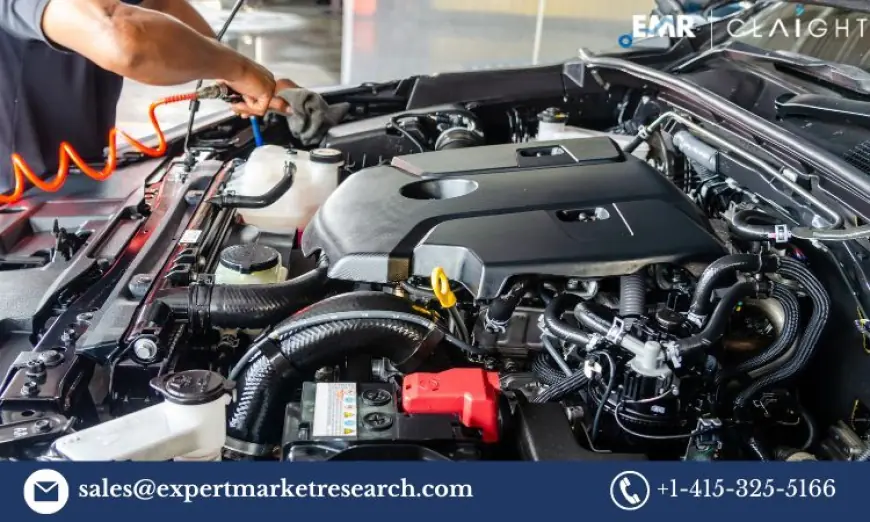Automotive Camless Engine Market Share, Size & Growth by 2034
The global Automotive Camless Engine Market Size is expected to witness substantial growth over the next decade, with a compound annual growth rate (CAGR) of 22.60% between 2025 and 2034.

Market Overview
The global Automotive Camless Engine Market Size is expected to witness substantial growth over the next decade, with a compound annual growth rate (CAGR) of 22.60% between 2025 and 2034. This market growth is fueled by the increasing demand for high-efficiency, low-emission engines that can meet stringent regulatory standards for fuel consumption and emissions. Camless engines, which eliminate the need for traditional mechanical camshafts and valves, offer a more adaptable and precise method of controlling engine performance. This makes them an attractive solution for both traditional internal combustion engines and hybrid systems.
Key Benefits of Camless Engines
-
Improved Fuel Efficiency: Camless engines offer enhanced fuel efficiency as they allow for better control over the intake and exhaust valves, leading to optimal combustion timing and reduced fuel consumption. This results in lower emissions and a reduction in the overall environmental impact.
-
Reduced Maintenance Needs: Traditional camshafts are subjected to significant wear and tear over time. In contrast, camless engines feature more robust designs, reducing the need for regular maintenance. With fewer moving parts, camless engines have fewer components to repair or replace, translating to lower maintenance costs.
-
Enhanced Performance: Camless engines can operate with more flexible valve timing, improving performance in a range of operating conditions. This results in more responsive acceleration, higher power output, and better overall engine performance compared to conventional engines.
-
Lower Emissions: Camless engines allow for precise control of the combustion process, leading to reduced emissions. As automakers face increasingly stringent emission regulations, camless engines present a solution to help meet these requirements while still delivering high power output.
-
Compact Design: With the elimination of the camshaft, camless engines can be more compact and lighter than their traditional counterparts. This not only reduces the weight of the engine but also allows for more flexible engine configurations in a variety of vehicles.
Key Industry Developments
Several key developments in the automotive camless engine sector indicate significant potential for growth and innovation:
-
Technological Advancements: Researchers and engineers are constantly refining camless engine technologies. Companies like FreeValve have developed valve actuation systems that allow for fully independent control of intake and exhaust valves, offering greater flexibility in engine performance.
-
Increased R&D Investment: Major automotive manufacturers and component suppliers are investing heavily in research and development of camless engine technologies. This focus on innovation aims to improve engine performance, reduce costs, and meet the increasing demand for environmentally friendly solutions.
-
Regulatory Pressure: As governments around the world introduce stricter emissions standards, automakers are compelled to adopt technologies that reduce fuel consumption and emissions. Camless engines, with their superior efficiency and lower emissions, have gained traction as a promising solution to comply with these evolving regulations.
Driving Factors of the Market
The automotive camless engine market is driven by several factors that are propelling its adoption and growth:
-
Fuel Efficiency and Environmental Regulations: The growing demand for fuel-efficient vehicles to meet strict emission norms is one of the primary drivers. Governments around the world are imposing increasingly stringent CO2 emissions standards, leading to the adoption of camless technology to enhance fuel efficiency and reduce the carbon footprint of vehicles.
-
Consumer Demand for High-Performance Vehicles: With rising consumer interest in performance vehicles, automakers are seeking technologies that provide superior power output, better throttle response, and overall higher engine efficiency. Camless engines meet these requirements, further stimulating market growth.
-
Innovation in Automotive Powertrains: The shift towards hybrid and electric powertrains has created a need for more efficient internal combustion engines. Camless engines offer the flexibility and efficiency needed for the evolving landscape of automotive powertrains, supporting their integration into hybrid and electric vehicle systems.
Impact of COVID-19 on the Automotive Camless Engine Market
The COVID-19 pandemic had a profound impact on global markets, including the automotive industry. Manufacturing shutdowns, disruptions in supply chains, and declining consumer demand resulted in a slowdown in vehicle production. However, as the world gradually recovers from the pandemic, the automotive industry is witnessing a resurgence in demand. This recovery is expected to accelerate the adoption of innovative engine technologies, including camless engines, as manufacturers strive to meet new performance and efficiency standards.
Restraining Factors
Despite the promising potential of camless engines, there are several challenges that may restrain market growth:
-
High Initial Costs: The technology involved in camless engines is still in its nascent stages, and the cost of development and production remains high. The complexity of the system, which requires advanced electronics and precision engineering, makes camless engines more expensive than traditional engines, which can deter widespread adoption.
-
Compatibility with Existing Infrastructure: Many automakers are hesitant to adopt camless engine technology due to the compatibility issues with existing manufacturing and repair infrastructure. The transition to camless engines requires significant changes in production processes, which can be costly and time-consuming.
-
Consumer Awareness and Acceptance: While camless engines offer significant advantages in terms of efficiency and performance, consumer awareness of these benefits is still limited. Overcoming the skepticism of consumers and educating them on the advantages of camless technology will be essential for widespread adoption.
Market Segmentation
The automotive camless engine market can be segmented based on the following factors:
-
Engine Type:
- Gasoline Engines: Gasoline-powered vehicles have been the primary market for camless engine technology due to the flexibility and efficiency improvements it offers in terms of fuel consumption and emissions.
- Diesel Engines: Diesel engines are also increasingly adopting camless technologies, as they offer improvements in power delivery, fuel economy, and emissions control.
-
Vehicle Type:
- Passenger Vehicles: Passenger cars represent the largest segment for camless engines, driven by the demand for fuel-efficient and high-performance engines.
- Commercial Vehicles: The use of camless engines in commercial vehicles, including trucks and buses, is expected to increase, driven by the growing focus on reducing operational costs and improving fuel efficiency.
-
Component Type:
- Valves: The valve actuation system is one of the most important components in a camless engine. Companies are developing advanced valve technologies that offer improved control over engine timing and efficiency.
- Actuators: The actuators in camless engines play a crucial role in controlling valve movement. The development of high-performance actuators is key to the success of camless engine technologies.
Regional Analysis/Insights
The automotive camless engine market is witnessing steady growth across different regions, driven by various factors such as technological advancements, government regulations, and the demand for eco-friendly solutions. Key regions include:
-
North America: North America, particularly the United States, is expected to witness significant growth in the camless engine market, driven by the demand for high-performance vehicles and a strong automotive manufacturing base.
-
Europe: Europe is a major hub for automotive innovation, with several manufacturers leading the charge in developing and implementing camless engine technology. Stringent emission regulations in the region are also driving the adoption of these engines.
-
Asia-Pacific: The Asia-Pacific region, led by countries such as China, Japan, and South Korea, is home to some of the largest automotive markets in the world. The growing demand for fuel-efficient and environmentally friendly vehicles is expected to spur the growth of camless engines in this region.
Major Key Players in the Market
Several key players are leading the development and commercialization of camless engine technologies. These include:
- Freevalve AB
- Musashi Engineering Inc.
- BorgWarner
- ElringKlinger AG
- Parker Hannifin Corporation
- Others
Opportunities and Challenges
Opportunities:
- Growing Demand for Hybrid and Electric Vehicles: The increasing adoption of hybrid vehicles presents opportunities for camless engines, as these engines are often used in conjunction with electric motors to optimize fuel efficiency.
- Technological Advancements: Ongoing advancements in valve actuation and control systems present new opportunities for improving the efficiency and performance of camless engines, further driving market growth.
Challenges:
- Cost and Scalability: High production costs and scalability concerns remain significant hurdles to mass adoption.
- Integration with Legacy Systems: The challenge of integrating camless engines with existing manufacturing processes and vehicle designs could slow the pace of adoption.
What's Your Reaction?
 Like
0
Like
0
 Dislike
0
Dislike
0
 Love
0
Love
0
 Funny
0
Funny
0
 Angry
0
Angry
0
 Sad
0
Sad
0
 Wow
0
Wow
0












































